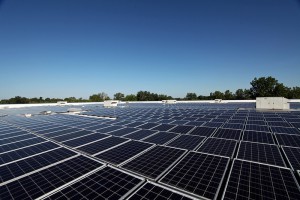5 reasons Michigan utilities should give us solar

The Michigan Public Service Commission recently issued a report summarizing the work of a group assembled to find ways to deploy more solar power in Michigan. The report offers possibilities for expanding the small programs offered by Michigan’s two biggest utilities for customers who want to generate solar power at home, but it doesn’t compel the utilities to take any action.
However, the commission any day will issue an order on Consumers Energy’s plans for renewable power – one that could have some legal teeth. MEC and other allies are urging the commission to use the opportunity to order Consumers and DTE Energy to expand their solar offerings.
If you support clean solar power for Michigan, we urge you to share your thoughts with the commission and the utilities. It’s quick and easy – just fill out this very brief form.
And if you need some convincing, below are the top five reasons—and there are many others not listed here—why it’s so important that Michigan’s two biggest utilities expand their solar power programs.
- We’ve already paid for it. DTE and Consumers together are sitting on about $26 million in surcharges they’ve already collected from Michigan customers. That’s because they overestimated the cost of developing renewable energy projects. A draft version of the MPSC’s report issued in June showed that, with the surcharges already collected, the utilities could significantly expand their solar programs without raising rates.
- It will create jobs. Roughly 2,700 people already are employed by the solar industry in Michigan. That’s nothing to sneeze at, but it’s a small slice of the 143,000 solar jobs nationwide. Steady, predictable growth in rooftop solar would be a boon for solar installers and would fuel the expansion of companies like Suniva, which this week announced it would bring 350 new jobs to Saginaw Township.
- It’s an important—and increasingly attractive—carbon-cutting tool. The solar power already installed in the U.S. is enough to offset nearly 17 million metric tons of carbon dioxide annually. Adding solar capacity will be an important wedge to help Michigan comply with the federal Clean Power Plan rule, which I outlined here . Meanwhile, solar is looking better all the time as panels become both cheaper and more efficient at an impressive rate. And, of course, solar power provides price stability; once you install the technology, the fuel is free.
- There’s pent-up demand. The utilities have used a lottery system to determine which customers they’ll contract with to buy rooftop solar. The rates they’ve paid to those customers don’t fully reflect the true value of solar power. As a result, many customers who want to be part of Michigan’s clean-energy transition have been stifled, and solar installers have suffered from boom-and-bust cycles created by the lottery schedule. The utilities should enter contracts to purchase rooftop solar power on a first-come, first-served basis, and they should pay a fair rate for it.
- We’re falling behind. It’s a common misperception that Michigan isn’t sunny enough for solar power to be a significant energy source. In fact, we have vast untapped solar potential. Grand Rapids, for example, has 87% as much capability for solar generation as Miami. New York, New Jersey, Pennsylvania and Maryland—each of which get about as much sunshine as Michigan—each added 50 megawatts of solar in 2012, while Michigan added just 11 megawatts.
Please take a moment today to tell Michigan’s utilities you want more solar power, and encourage your friends to do the same. Thanks!
###
Photo by Logan Chadde.
Browse these next
- Non Gamstop Casino
- Casino Online Migliori Italia
- Non Gamstop Casinos
- Casinos Not On Gamstop
- Casino Online Non Aams
- Non Gamstop Casino UK
- Best Non Gamstop Casinos
- Best Non Gamstop Casinos
- Online Betting Sites Not On Gamstop
- Non Gamstop Casino UK
- UK Casinos Not On Gamstop
- UK Casino Not On Gamstop
- Gambling Sites Not On Gamstop
- Casinos Not On Gamstop
- Non Gamstop Casino
- Casino En Ligne Meilleur Site
- Casino En Ligne Meilleur Site
- Casino En Ligne France
- Non Gamstop Casino Sites UK
- Top UK Casino Sites
- Best Online Casinos Uk
- Lista Casino Online Non Aams
Comments are closed.



the technology exists why are we not moving with the rest of world in bringing renewable energy to this state?
Chris,
Instead of encouraging DTE and Consumers, two super sized corporate monopolies to develop Solar power and continue to control a state covering grid centrally, MEC
should encourage the state legislature and administration, including the PSC to provide incentives that encourage and enable municipalities and neighborhoods in cities to develop community owned and operated solar generating, storage and short range distributing systems, often, now ‘days called distributive systems. Micro grids can be used for storage and distribution of community power. That is being done in Chelsea, Wyandotte and a few other Michigan small cities. They don’t go out when central grid goes down. Rural electric co-ops have operated successfully for years. They can inter-connect to support one another in emergencies and at peak use times.